Ø1" (Ø25 mm) Post Holders
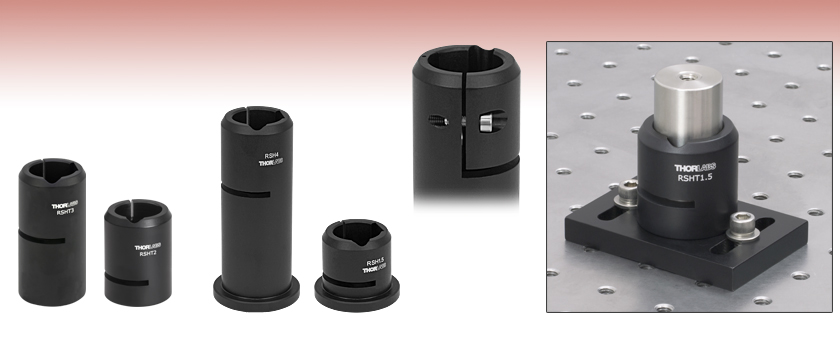
- Hold Ø1" (Ø25 mm) RS Pillar Posts
- Flexure Design Provides Stability
- Bottom-Located Tapped Hole or Pedestal Base
Rear Flexure
Locking Mechanism
RSH1.5
RSHT3
RSH4
RSHT2
RSHT1.5 Post Holder on a BA2 Base
Bottom-Located Tap
Pedestal Base

Please Wait
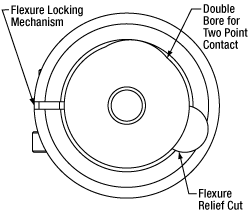
Top View of Ø1" Post Holders Showing the Flexure Lock and Relief Cuts
Features
- Post Holders with Flexure Locking Mechanism for Ø1" Posts
- Available Lengths: 1.5" (38 mm), 2" (50 mm), 3" (75 mm), and 4" (100 mm)
- Imperial and Metric Locking Options Available
These Ø1" (Ø25 mm) Post Holders are the ideal solution for mounting optical components with maximum stability and an adjustable height. They are designed to be used with our stainless steel Ø1" Posts, which are offered in a range of fixed heights. These post holders provide the same level of stability as a pillar post directly threaded into an optical table or a pedestal post secured with a clamping fork. When using a longer post, a taller post holder should also be used to ensure the greatest stability. Please see the Stability tab for more information and the results of an experiment comparing various mounting options.
The flexure design of the post holder supports the post in a clamping mechanism that is secured with an 8-32 (M4) cap screw using a 9/64" (3 mm) hex key. The circular groove in the central bore allows the metal to flex and clamp the post's position without breaking. When locked, the square groove provides two fixed contact lines with the post to maximize the clamping force. The RSHT post holders have a base with a bottom-located 1/4"-20 (M6) tapped hole for mounting. This allows these post holders to be used with our Post Holder Bases, such as the BA2. This design does not allow a post to pass all the way through the post holder and always leaves the post resting at least 0.24" (6.1 mm) above the table surface. By contrast, the RSH post holders have a pedestal base and can be easily secured to a breadboard or optical table using the PF85B, PF125B, or PF175B clamping fork. The central bore of these post holders goes through the base, allowing Ø1" posts to pass all the way through the post holder and rest on the optical table surface for minimum beam height.
We also offer Ø1" post mounts, which mount a Ø1" post to an optical table without the use of a clamping fork.
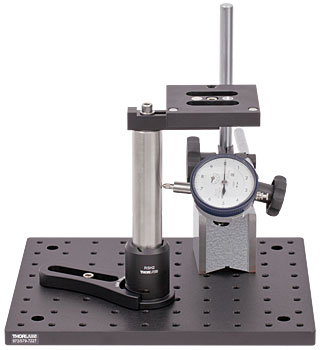
Click to Enlarge
Stability Test Apparatus
The stability of a Ø1" post mounted in an RSH flexure post holder was compared to that of a post directly threaded to a breadboard and a post with a pedestal base secured to a breadboard with a clamp. The experimental apparatus consisted of an RS6 post held in an RSH post holder that was clamped to a breadboard with a PF175 clamping fork. A 2" moment arm was clamped to the post, and a variable load was applied to the end of the arm. As different loads were applied to the moment arm, the deflection of the post was measured with a dial indicator. The experiment was then repeated with the post threaded directly into the breadboard and with a pedestal post secured by a clamping fork. The results are shown in the graph below.
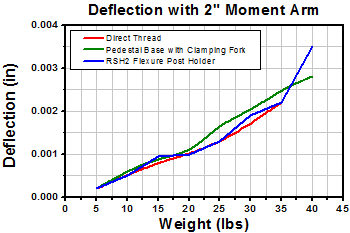
Click to Enlarge
Results of an Experiment Investigating the Deflection of a Ø1" Post Under a Variable Load for Different Mounting Conditions
The test results indicate that, within the accuracy of the measurements, the RSH post holder is just as stable as the other two mounting options. However, instabilities can be introduced when a shorter post holder is used with a longer post. We recommend that you use a taller post holder with taller posts to avoid any loss of stability.
| Posted Comments: | |
Anton Ryzhov
(posted 2021-05-01 13:51:31.373) What is the height (thickness) of the bottom? I don't see this measure in the drawing. YLohia
(posted 2021-05-03 01:40:09.0) Hello, the thickness of the bottom of the RSHTx series is 6.35 mm. user
(posted 2020-01-29 19:04:41.303) Are the metric post holders intended to have a looser fit with the pillar post, compared to the imperial post holders? For example RSHT2/M post holder (25.5mm ID) with RS50P4/M pillar post (25.0mm OD) has 0.5mm diametral clearance; while RSHT2 post holder (25.5mm ID) with RS2P8 pillar post (25.4mm OD) has only 0.1mm diametral clearance. Wondering if I should use the imperial series instead of the metric series if I want a closer fit. llamb
(posted 2020-01-31 10:24:38.0) Thank you for your feedback. Besides height and bottom tap differences, both metric and imperial post holders are manufactured in the same way to save on production costs, and would both work for clamping onto Ø25 mm and Ø1" posts. You are correct regarding clearances, so if there is no strict concern regarding overall height or mounting taps, then using imperial posts would indeed give you a tighter fit. cvoth
(posted 2015-04-08 10:30:48.79) I also agree. I need a tapped 1/4-20 hole on the bottom. jlow
(posted 2015-04-14 10:24:01.0) Response from Jeremy at Thorlabs: Thank you very much for the feedback. I have forwarded this request to the product engineer and we will look into this. yan.jiang2
(posted 2015-01-14 17:09:25.27) I agree with david.thompson.
I also want to have an adjustable height 1" post. These would be great if there was a tapped 1/4-20 hole on the bottom. cdaly
(posted 2015-01-20 03:27:35.0) Response from Chris at Thorlabs: Thank you for your feedback. We will look into the possibility of adding this feature to the post holders. david.thompson
(posted 2014-06-25 15:50:19.343) these post holders lack the 1/4-20 tap on the bottom that would enable them to be mounted to base plates. I just ordered one to support an optical isolator. I am disappointed because I would like to mount it to a base plate, so that if we move it around it will be more stable. Forks are great for tight places, but bad for balance when storing or temporarily moving things. I wish that this mount had both options. You buy these for stability. But if you risk something tipping over when it is untightened and bumped that's not a great tradeoff...THanks cdaly
(posted 2014-08-06 05:16:32.0) Response from Chris at Thorlabs: Would it be possible instead to use ether the BA2F(/M) or RB2(/M) clamp with your 1" diameter posts? These are generally pretty stable and can eliminate the need for the post holder and clamping fork all together if the post is reasonably close to the required height. sharrell
(posted 2012-06-21 13:54:00.0) Response from Sean at Thorlabs to Last Two Posters: Thank you for your feedback on our new Ø1" Post Holders! We have indeed updated the graph on the "Stability" Tab. The original version showed two sets of data using the new post holders: a 6" long post in a 2" long post holder, and a 6" long post in a 1.5" long post holder. We do not recommend using such a short post holder for this length of post, and it was our hope that this would be clear from the plot. Based on your comment, we decided to show only recommended mounting options in the plot. In addition, we are reviewing the text on this tab to be sure that the test parameters and the recommended mounting options are clear. user
(posted 2012-06-21 13:16:42.0) Much better now. Saleau
(posted 2012-06-21 04:03:03.0) Your deflection graph is strange. If I believe it then I should not buy this post holder since the usual mounting is better. Do you not wish to sell these? |


Click to Enlarge
Bottom View of an RSHT2/M Post Holder
- Flexure Lock Post Holders for Ø1" (Ø25 mm) Posts
- Bottom-Located 1/4"-20 (M6) Tap for Direct Mounting
- Available Lengths: 1.5" (38 mm), 2" (50 mm), 3" (75 mm), and 4" (100 mm)
RSHT post holders have a 1/4"-20 (M6) tapped hole for mounting located in the bottom of the base. These post holders can be used with our standard Post Holder Bases, such as the BA2.

- Flexure Lock Post Holders for Ø1" (Ø25 mm) Posts
- Pedestal Base for Use with PF85B, PF125B, or PF175B Clamping Fork (Sold Separately Below)
- Post Can Pass Through Post Holder for Minimum Beam Height
- Available Lengths: 1.5" (38 mm), 2" (50 mm), 3" (75 mm), and 4" (100 mm)
RSH post holders have a pedestal base and can be easily secured to a breadboard or optical table using the PF85B, PF125B, or PF175B Clamping Forks (sold separately below). The central bore of these post holders goes through the base, allowing Ø1" posts to pass all the way through the post holder.

The PF85B, PF125B, and PF175B clamping forks secure RSH post holders to any breadboard or optical table. These clamping forks create three points of contact with the table for high stability. For flexibility in the positioning of post assemblies, Thorlabs offers three sizes: the PF85B fork has a 0.85" (21.6 mm) long counterbored slot, the PF125B fork has a 1.25" (31.8 mm) long counterbored slot, and the PF175B fork has a 2.12" (53.8 mm) long counterbored slot.
Please note that significant overtightening of clamping forks can deform the surface of an optical table, which can cause misalignment of components and decrease stability of the clamping fork.
These clamping forks are also available in packs of five.
 Products Home
Products Home







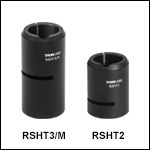
 Zoom
Zoom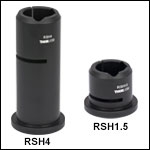
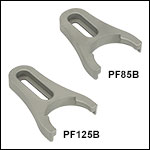
 Ø1" Post Holders
Ø1" Post Holders